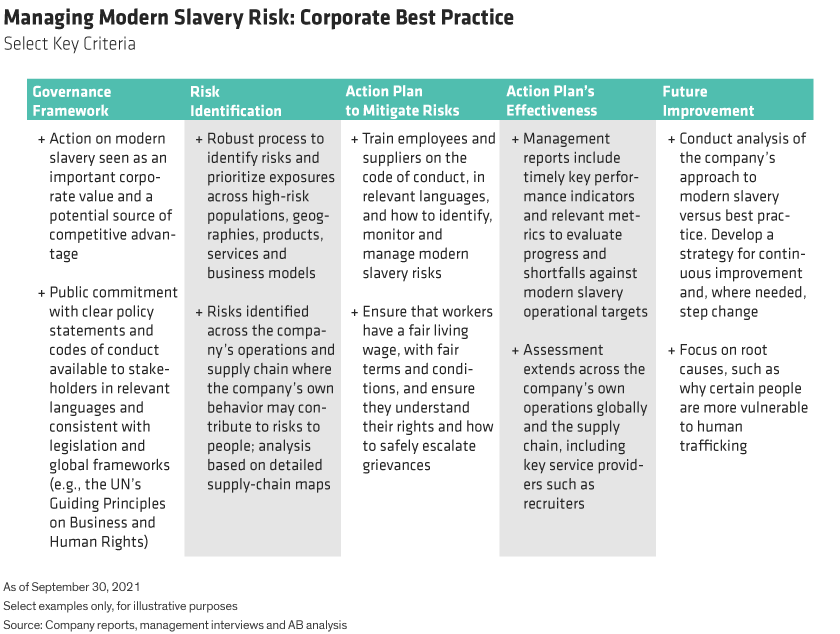Written by: Michelle Dunstan and Saskia Kort-Chick
With profits from forced labor estimated at US$150 billion a year, some companies in global portfolios could be unwittingly associated with modern slavery. The good news: businesses and investors can help tackle the problem—individually and through collaboration.
Investors, for example, can assess the risks of modern slavery in their own portfolios by using a tailored research approach. This effort is helped by the obligations of many companies, under modern slavery regulations, to assess and report risks in their operations and supply chains.
Collaboration comes into play when investors engage directly with companies to understand how they’re managing modern slavery risk in their businesses and to encourage them to take concrete steps to reduce it. We believe that it’s critical to have a clear idea of corporate best practices in managing modern slavery risk when engaging with companies. It enables investors to understand the company better and to understand—and act on—the risks.
In other words, engagement has two benefits: better investment insights and better corporate practices, which can help push back against practitioners of modern slavery and relieve the human suffering they cause. It’s exciting to watch firms deepen their engagement with modern slavery, with many realizing that taking a stand against modern slavery helps not only its victims but their own brands.
Dimensioning Corporate Best Practices on Modern Slavery
So, what exactly constitutes corporate best practices? We’ve collaborated with certain companies to identify five criteria—a collective benchmark for best practices in managing modern slavery risk, or risks to people:
-
Governance Framework: What steps are the board and senior management taking—through policies and procedures, as well as company culture and values—to align the business with the goal of reducing modern slavery risk?
-
Risk Identification: The criminal and covert nature of modern slavery practices makes this a difficult and delicate task. How well does the company understand the challenge, and how robust are the techniques and processes it uses to identify the risk?
-
Action Plan to Reduce Risks: Is the plan a realistic solution to reduce risk to people within the company and its supply chains? Does the firm appropriately identify the risks and effectively train and empower employees and suppliers to engage with them and reduce them?
-
Action Plan Effectiveness: To what extent have the company’s actions reduced risk, and how are the board and senior executives measuring progress? What procedures are in place to ensure that follow-up actions are implemented and monitored?
-
Future Improvement: For many companies, the road to reducing modern slavery risk will be long, through unfamiliar territory. The best companies will be able to evaluate their progress each step of the way and make changes with an eye to continuously improving their performance against each of the criteria.
For each category, we’ve developed multiple criteria for assessing individual companies (Display).

The Four Phases of Modern Slavery Learning and Improvement
This framework—particularly the future improvement component—recognizes that best practice is a process of continuous learning and improvement, with companies moving through four phases. From an initial “laissez-faire” attitude, firms than begin to acknowledge modern slavery as a risk that needs to be managed (primarily as a reputational issue).
In the third phase, they become involved in the cause through charity. Finally, they accept that modern slavery risk in their supply chains is at the heart of what they stand for as a firm—and that reducing that risk should be part of their core values. It’s at this point that the fight against modern slavery becomes part of their brand identity and a source of competitive advantage.
We’ve found that talking to a company’s supply-chain manager—a necessary part of engaging on modern slavery risk—can yield valuable information and investment insights beyond those already received from the company’s board, senior executives, suppliers and competitors. This helps strengthen the conviction behind stock selection.
Just as important, engagement between investors and corporates, based on a sound knowledge of corporate best practices in addressing modern slavery, may lead over time to both real progress in the fight against this pervasive social evil and better outcomes for its victims.
Related: The Synthetic Biology Revolution: Investing in the Science of Sustainability


